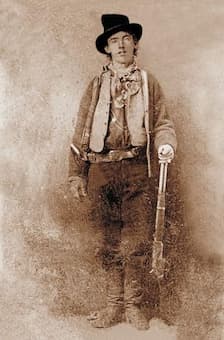
Billy the Kid (ca. 188)
The American tragedy these days is gun violence and how it has become a part of the familiar scene. It seems like most films from the US have a gun in the imagery and the news is filled with today’s mass annihilation of the innocent.
When you look at American history, it’s the gunfighters who still live in modern history and one of them as Henry McCarty. Don’t recognize the name? How about his pseudonym of William H. Bonney? Still nothing? How about Billy the Kid? How do you remember someone who died, age 21, in the New Mexico Territory 140 years ago?

Aaron Copland, ca. 1936
His story was picked up by American composer Aaron Copland and made into a ballet in 1938. The music was first arranged for 2 pianos, and then orchestrated in 1939, and the 7-movement orchestral suite was given its debut in New York in 1940. The ballet received its debut in Chicago in 1938 with Lincoln Kirstein’s Ballet Caravan company.
Billy was born in New York City before his family moved to Indiana when his father died and then to what was then New Mexico Territory, where his mother remarried. When Billy was 15, his mother died of tuberculosis and his stepfather abandoned Billy and his 11-year-old brother. Billy took up a life of crime and, although he was soon caught, he escaped prison and joined a gang. His famous boast was that he ‘killed 21 men, not counting Indians.’
Copland’s suite opens with a view of the open prairie. it’s a view that seems melancholic and fraught with portent. It’s characteristically Copland, but without the joy he seems always to imbue into so much of his music.
Aaron Copland: Billy the Kid Suite – I. Introduction: The Open Prairie (National Symphony Orchestra, Gianandrea Noseda, cond.)
We come into a town and the street fills with people of all kinds – going about their business, looking for business, or looking to steal someone’s business.
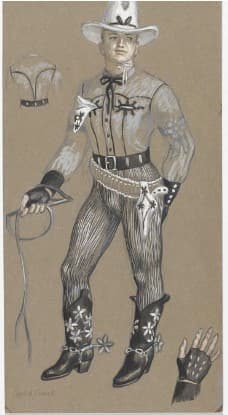
Jared French: Costume design for Billy (1938) (MoMA)
Aaron Copland: Billy the Kid Suite – II. Street in a Frontier Town (National Symphony Orchestra, Gianandrea Noseda, cond.)
Now we get some local colour – Copland had been to Mexico many times in the early 1930s, and his first work that brought his name to the world’s attention was the 1936 El Salón México. This kind of music is ideal for ballet companies as it permits them to show off all their dancers in a colourful style. Two fighters stage a duel and in a snap of gunshot, Billy’s mother is dead and he attacks the killer with a knife and starts his own killing career.
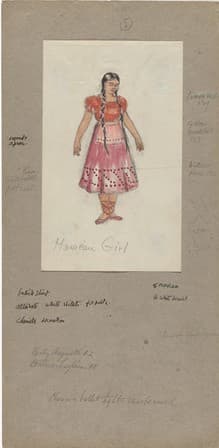
Jared French: Costume design for Mexican Girl (1938) (MoMA)
Aaron Copland: Billy the Kid Suite – III. Mexican Dance and Finale (National Symphony Orchestra, Gianandrea Noseda, cond.)
Next, we have scenes from Billy’s life: back out beyond below a sea of stars. In the background, you’ll hear traditional cowboy songs.
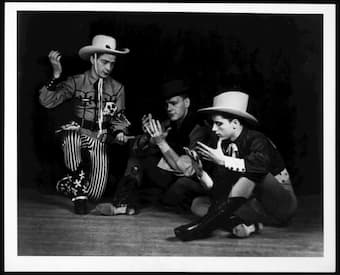
Billy the Kid (production shot) (1938)
Aaron Copland: Billy the Kid Suite – IV. Prairie Night: Card Game at Night (National Symphony Orchestra, Gianandrea Noseda, cond.)
Another scene from the life: Billy is pursued by a posse led by Pat Garrett that ends in a running gun battle. In the end, Billy is captured.
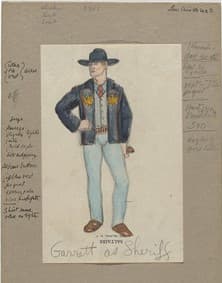
Jared French: Costume design for Pat Garrett as Sheriff (1938) (MoMA)
Aaron Copland: Billy the Kid Suite – V. Gun Battle (National Symphony Orchestra, Gianandrea Noseda, cond.)
Billy in prison quickly becomes Billy out prison, having escaped and now celebrating.
Aaron Copland: Billy the Kid Suite – VI. Celebration: After Billy’s Capture (National Symphony Orchestra, Gianandrea Noseda, cond.)
In the end, the posse catches up with him again for the very last time.
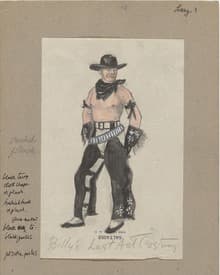
Jared French: Design for Billy’s Last Act Costume (1938) (MoMA)
Aaron Copland: Billy the Kid Suite – VII. Billy’s Death (National Symphony Orchestra, Gianandrea Noseda, cond.)
And, in the end, we return to the stage upon which the short, brief life of Billy the Kid, died age 21, is set: the open prairie. Do we hear this differently than we did the first time, knowing what secrets are buried under those vast expanses of the plains?
Aaron Copland: Billy the Kid Suite – VIII. The Open Prairie again (National Symphony Orchestra, Gianandrea Noseda, cond.)
When he was commissioned for the project by the impresario Lincoln Kirstein (1907-1996), Copland wasn’t sure he wanted to write cowboy music. Kirstein gave him a sheaf of songs, and some of them appear in the work, such as ‘Great Grandad,’ ‘Git Along, Little Dogies,’ ‘The Old Chisholm Trail,’ and ‘Goodbye Old Paint.’ Copland said he didn’t include ‘Home on the Range’ because he ‘had decided to draw the line someplace.’ Copland said it was a ‘…delicate operation … to put fresh and unconventional harmonies to well-known melodies without spoiling their naturalness.’
Encapsulating a brief and tumultuous life in a ballet is difficult – squeezing it down to a shorter suite condenses it even more. In Billy the Kid, Copland presents the great American tragedy – short, memorable, seemingly heroic, fleeting, and filled with gun violence.
For more of the best in classical music, sign up to our E-Newsletter

Excellent Analysis of score…!
Lincoln Kirsten was a forcefully driven master, driven with ambition to wave his magic, stimulating an artist’s creativity… Kirsten had formed a partnership with George Balanchine in developing ballet in The United States, as a result of his association with “The Ballet Russe du Monte Carlo” …in the early 1930’s…
…acquainted with inventive composers, Kirsten engaged Arron Copland to create this score for Balanchine’s and Kirsten’s new dance company …“Ballet Caravan”…
The French Parissiene “Ballet Russe du Monte Carlo” had been on a World Tour, initiated in New York City in 1938, appearing Nationally across the United States to San Francisco; embarked to Australia, New Zealand; returning to the West Coast, in Los Angeles, then a return to San Francisco, with further engagements, in their return to New York City, in early 1940…
Due to Hitler’s invasive actions, the production’s staff remained in NY.
What is interesting about the Ballet du Russe’s return to Los Angeles – Jack Warner engaged the ballet group’s return to the States, to be filmed at the Burbank Studio’s lot…. The costumes were copied, rebuilt in the studio’s wardrobe department, as new wardrobe, since the costumes had become slightly worn – OUT…! These two films are archived, available to view on DVD…